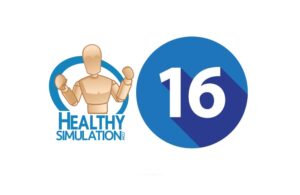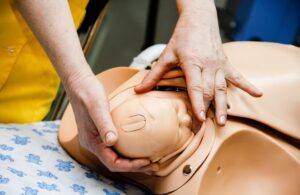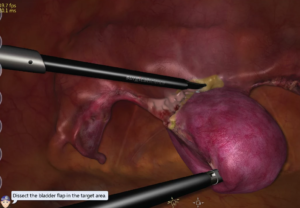OB Simulator
An OB Simulator, or an Obstetrics simulator, is a speciality manikin that realistically mimics a woman in the pregnancy phase/terms to labor and delivery to immediate postpartum phase. OB simulators can allow learners to practice care of the pregnant patient in a variety of environments that includes: office, home, pre-hospital, and hospital. These healthcare simulators can help learners to identify at-risk conditions early and manage to prevent further complications.
OB Simulators Help Learners Practice Responses to Obstetric Scenarios
Healthcare simulation as a whole is mainly about the educational process to practice medicine to achieve heightened patient safety. One of the areas of medical simulation that has yielded some of the most dramatic arguments to promote clinical simulation across education is Obstetrics and Gynecological-based simulation. The practice of simulated care for both mother and child up to and after the birthing process goes back to the 1600s. Obstetrics and Gynecological (OBGYN) simulation is a pillar of healthcare simulation, and the market has been and always will always be perplexing.
Sponsored Content:
Read A Quick Guide to Birthing Simulators & OBGYN Simulation that discusses the different types of OBGYN-based simulators available and shares a quick guide approach in regards to the proper simulator purchases for each respective healthcare simulation program. OB simulators allow learners to practice a wide variety of OB scenarios. These can include crucial and difficult conversations,
Types of OBGYN-based Medical Simulators Available
Task trainers : Of the available OBGYN-based simulation solutions, the task trainer is the lowest on the scale of fidelity. However, where there is a lack of fidelity, the OBGYN-based task trainer market compensates with variety. The OBGYN-based task trainer market has simulators to help teach almost every aspect of the Obstetric and Gynecological medical practice.
On the market, there exist task trainers for female-based exams, pregnancy-based scenarios, and post-labor-based practices. These task trainers display a number of regular and uncommon physiological characteristics that have a high level of detail to help increase participant buy-in. The OBGYN-based task trainers are specifically made only to encompass a specific area of OBGYN medical practice, such as childbirth or pelvic exams. The realism is only extended to that specific area of OBGYN medical practice, which leaves a task trainer to only be a female pelvis with no arms or legs to interact with for example.
Sponsored Content:
Some of the skills that can be practiced are recognition of fetal position and practice Leopold’s maneuver, cervical dilation, palpation of the ovary, and pelvic landmark identification. Another type of task trainer is the birthing stages trainer to allow the learner to visualize the birthing process and the physiological changes that occur to allow for vaginal births. While another task trainer allows the learner to practice nerve blocks for childbirth. There are postpartum hemorrhage task trainers available for professional healthcare students. As one can see, there are OB task trainers for use in medical simulation to meet a vast array of experiential opportunities. The task trainer can be the first step to scaffold the learner’s experience as the foundation for layered knowledge acquisition. Multiple healthcare simulation and supply companies are available to meet your needs.
View the HealthySimulation.com LEARN CE/CME Platform Webinars Creating Obstetric Neonatal Emergency Simulations in Developing Countries and Fidelity Matters: Ways to Maximize Learning by Using Simulated Participants and Wearable Hybrid Simulators to learn more about OB Simulators!
Wearables: Amongst the large selection of healthcare simulation teaching tools there is a type of tool with growth in popularity, the wearable/overlay simulator. This type of medical simulation education tool combines the wearable’s ability to add the realistic element of a live actor or standardized patient to provide opportunities to learn to incorporate communication with a live person. More specifically, in OBGYN-based medical simulations, there is a large difference in realism between the sound of a woman over a speaker and the actual interaction of a woman that speaks directly to the participant. The price for a wearable medical simulator can vary and depends on complexity but the overall market is still on the affordable side.
Some vendors that offer OB wearable simulators or overlays are:
- AvKin
- Simulaid
- Laerdal
Full Body Manikin Simulators: The high-fidelity simulators provide the ability to display a number of different conditions, all on the same “patient” who is always ready to be the “patient”. There is no limit to the number of exams and scenarios per day as with a standardized patient. The high-fidelity OBGYN simulator can be found in many healthcare simulation programs. The high-fidelity OBGYN simulator is like most high-end items, you get what you pay for. The higher the price point of a medical simulator will mostly translate into more heightened realism, more features, and an easier-to-understand user interface. The trade-off for higher fidelity in an OBGYN simulator is fewer simulators to choose from.
Some vendors that offer high-fidelity simulators are:
- CAE Juno, Lucina
- Laerdal MamaNatalie
- Gaumard Noelle
- Life/form Lucy Maternal
The Importance of Medical Training via OB Simulation
In 2020, 861 women were identified as maternal deaths in the United States, compared with 754 in 2019. The maternal mortality rate for 2020 was 23.8 deaths per 100,000 live births compared with a rate of 20.1 in 2019. In February 2023 the World Health Organization (WHO) published information that worldwide a woman dies every two minutes due to pregnancy and childbirth. UNICEF states the miracle of childbirth is marred by the tragedy of maternal deaths.
There are approximately 6700 newborn deaths every day, which equals to 47% of all child deaths under the age of 5 years, up from 40% in 1990. The world has made substantial progress in child survival since 1990. Globally, the number of neonatal deaths declined from 5 million in 1990 to 2.4 million in 2020. Preterm birth, intrapartum-related complications (birth asphyxia or inability to breathe at birth), infections and birth defects are the leading causes of most neonatal deaths.
Obstetrics Simulator Latest News

16 Must-Know Healthcare Simulation Key Terms

Tecnología Háptica en la Simulación Obstétrica: Avances y Aplicaciones

How to Run a Postpartum Hemorrhage Nursing Simulation Scenario

A Two-Step Process for Choosing a Birthing Simulator

The Role of Surgical Simulation in Contemporary OB/GYN Training
Sponsored Content:
















